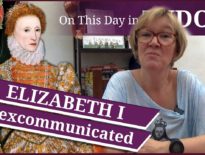On this day in Tudor history, 24th February 1603, Katherine Howard (née Carey), Countess of Nottingham, died at Arundel House.
Katherine was a close friend of Queen Elizabeth I and it is thought that grief over her friend's death had a major impact on the queen's own health, for she died just a month later.
Find out who Katherine was, how she rose to be the queen's good friend, and also hear about a myth associated with her in today's talk.
Also on this day in history, 24th February 1500, Charles V, Holy Roman Emperor, was born. Hear some Charles V facts in last year’s video:
Also on this day in history:
- 1525 – Battle of Pavia. The French were defeated by Imperial troops and Francis I was taken prisoner. Richard de la Pole, son of John de la Pole, 2nd Duke of Suffolk, and a claimant to the English throne, was killed in the battle.
- 1540 – Birth of Henry Howard, Earl of Northampton, courtier, author and administrator, at Shottesham in Norfolk. He was the second son of courtier and poet Henry Howard, Earl of Surrey, and his wife, Lady Frances de Vere. After his father's execution in 1547, Howard was put into the care of his aunt, Mary Howard, Duchess of Richmond, who appointed John Foxe, the martyrologist, and scholar Hadrianus Junius to educate him and his brothers. Between 1553 and 1558, Howard served Bishop John Whitgift as a page, and in 1559 he went to King's College, Cambridge, to study. He went through periods of disfavour in Elizabeth I's reign due to his links with Catholics, but he rose in favour in the late 1590s due to his friendship with the Earl of Essex and then his links with the Cecil faction at court. He served James I as a privy councillor, constable of Dover Castle and lord warden of the Cinque Ports, and Lord Privy Seal. He was created Baron of Marnhull, Dorset, and Earl of Northampton in 1604.
- 1580 – Death of Henry Fitzalan, 12th Earl of Arundel, at Arundel House. He was buried in the collegiate chapel at Arundel. Fitzalan was a member of the jury at the trials of George and Anne Boleyn and served Henry VIII as Deputy of Calais, Privy Councillor and Lord Chamberlain. He was High Constable at Edward VI's coronation, and was among the men who signed Edward VI's letters patent naming Lady Jane Grey as his successor. He swapped sides after Edward's death and joined those supporting Mary I, acting as High Constable at her coronation and serving her as Lord Steward of the Household. He was not favoured in Elizabeth's reign, and was actually put under house arrest at times.
Transcript:
On this day in Tudor history, 24th February 1603, Katherine Howard (née Carey), Countess of Nottingham, died at Arundel House. She was buried at All Saints, Chelsea (Chelsea Old Church) on 25th April 1603.
Katherine was the eldest daughter of Henry Carey, 1st Baron Hunsdon, and his wife, Anne Morgan, making her the granddaughter of Mary Boleyn, sister of Queen Anne Boleyn. Her birthdate is not known, but must have been between 1545 and 1550.
By 1551, Katherine’s father was serving as a gentleman in Elizabeth’s household and her mother also had connections to the princess’s household, being the granddaughter of Blanche Herbert, Lady Troy, Elizabeth’s Lady Mistress. Elizabeth came to the throne in November 1558 and Katherine herself was appointed as a Gentlewoman of Elizabeth I's Privy Chamber in 1560. Katherine’s biographer, Simon Adams, notes that Elizabeth and Katherine were obviously close friends as the queen disguised herself as one of Katherine’s maids so that she could watch Robert Dudley shoot at Windsor in 1561.
Katherine married Charles Howard, 2nd Baron Howard of Effingham and 1st Earl of Nottingham, in 1563, and the couple went on to have at least 5 children. Katherine’s daughters, Elizabeth and Frances, also served the queen as maids of honour, as did her granddaughter, Elizabeth Southwell.
Katherine also served the queen as her carver, meaning that she was responsible for receiving the queen’s food and serving it on plates. From 1572, she was chief lady of the privy chamber, and in 1598 Katherine was listed as being one of the queen’s grooms of the stool, i.e. she helped with the queen’s toileting. She was also one of the ladies the queen trusted with caring for her jewels. Her husband, Effingham, served as a gentleman of the privy chamber, was elected to the Order of the Garter in 1575, and joined the privy council in 1584, becoming Lord Chamberlain. In 1585, Elizabeth appointed him as her Lord High Admiral and he acted in this role in the 1588 Spanish Armada trouble and in 1596 in Cadiz.
In 1591, the queen granted Katherine and Effingham the manor of Chelsea in 1591 and in 1597 she made Effingham Earl of Nottingham, the second highest peer in England.
Katherine became ill in 1601 and never recovered, dying on this day in 1603 at Arundel House, having suffered a number of “fits”. The queen was devastated by her death, with one contemporary noting that she took news of her friend’s death “muche more heavyly” than Katherine’s own husband did. A courtier remarked: “The Queen loved the countess well, and hath much lamented her death, remaining ever since in a deep melancholy that she must die herself, and complaineth of many infirmities wherewith she seemeth suddenly to be overtaken.” Katherine’s brother, Robert Carey, noted that the queen had a “melancholy humour” and that she made more than “forty or fifty great sighs” as she spoke to him. The women had been close for over 40 years, so Katherine’s death was a heavy blow for Elizabeth. It is said grief was a factor in the decline of the queen’s own health. Elizabeth died just a month later.
Trivia: There is a myth about the Countess of Nottingham. According to this myth, Katherine played a role in bringing down her husband’s enemy, Robert Devereux, Earl of Essex. The queen had once promised Essex that if she ever became angry with him then he was to send her a ring she had given him and that on receipt of it, she would forgive him. It was alleged that following the Essex Rebellion of 1601, Essex tried to send the ring to the queen, but Katherine intercepted it and withheld it from the queen. When Katherine was dying, the queen who had heard of Katherine’s part in Essex’s fall, said to he “God may forgive you, Madam, but I never shall.” It’s a great story, but it has no basis in fact and dates only to the 17th century.
Book recommendation: Elizabeth I and her circle by Susan Doran.



Leave a Reply